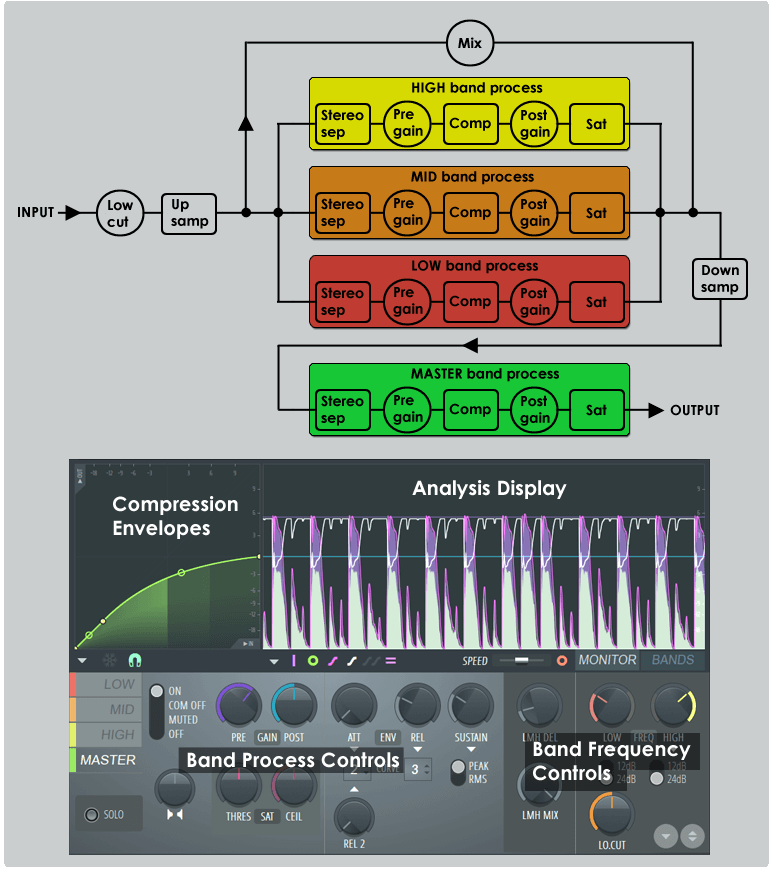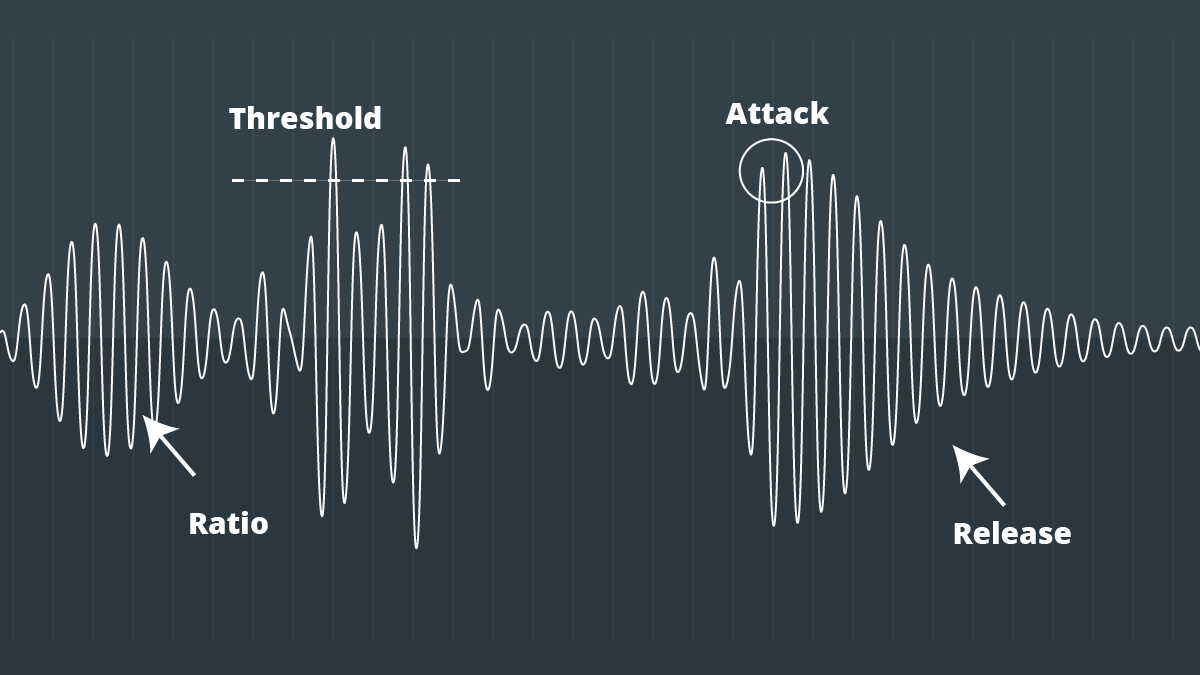In sidechain compression, the signal of one track controls the compression of another to create dynamic mixes. It enhances clarity and impact in music production.
This guide will explain how to set up sidechain compression for effective audio processing. Sidechain compression is a powerful tool used in various genres to give space and balance in the mix, making instruments stand out while ensuring they work harmoniously together.
By learning how to properly implement sidechain compression, you can elevate your music production skills and achieve professional-sounding results. Understanding the fundamentals of sidechain compression will enable you to fine-tune your music and bring out the best in your tracks, leading to a more cohesive and polished final product.

Credit: www.image-line.com
The Basics Of Sidechain Compression
Sidechain compression is a powerful tool used in audio production to create dynamic mixes by allowing one sound to control the intensity of another. Understanding the basics of sidechain compression is essential for enhancing the impact and clarity of your tracks.
What Is Sidechain Compression?
Sidechain compression is a technique where the level of one audio signal (the sidechain input) triggers the compression of another audio signal (the main input). This means that when the sidechain signal reaches a certain threshold, it activates the compressor on the main signal, reducing its volume.
Understanding The Parameters
Threshold: The level at which the sidechain signal activates the compressor on the main input.
Ratio: Determines how much the main signal is compressed when the sidechain signal exceeds the threshold.
Attack: Controls how quickly the compressor reacts once the threshold is surpassed.
Release: Dictates how long it takes for the compressor to stop compressing once the signal falls below the threshold.
Selecting The Right Source And Destination
Selecting the right source and destination is crucial when using sidechain compression in your audio projects.
Identifying The Primary And Secondary Tracks
Identify your primary track for compression and secondary track for sidechain input.
Setting Up The Sidechain Input
Ensure the sidechain input is properly configured for each track in your audio project.
Advanced Techniques For Creative Mixing
Applying Rhythmic Pumping Effects
Rhythmic pumping effects can add dynamic energy to a mix, heightening impact and enhancing groove. Using sidechain compression, you can create this effect by creating a rhythmic link between the kick drum and bassline, where the bass subtly ducks out of the way of the kick, then bounces back into place, giving a pulsing sensation to the mix.
Exploring Frequency-specific Compression
Utilizing frequency-specific compression allows for precise control over individual frequency bands. By targeting specific problem areas, such as excessive low-end on a vocal track, you can sculpt the sound to achieve a more balanced and polished mix that retains warmth and clarity. This technique is particularly effective for instruments and vocals that require frequency-specific attention.

Credit: m.facebook.com
Optimizing Sidechain Compression For Various Instruments
Mastering sidechain compression for different instruments can elevate your audio production. Learn how to tailor this technique to optimize the sound of each instrument in your mix, achieving a balanced and professional-grade result. Discover the nuances of sidechain compression to enhance your musical creations with precision and artistry.
Sidechain compression is an essential technique used in audio production to create a dynamic and pumping effect. By using sidechain compression, you can achieve a balanced mix and prevent certain instruments from overpowering others. While sidechain compression is commonly used on the kick and bass, it can also be applied to vocals and other instruments to create space and clarity in your mix.
Sidechaining For Kick And Bass
When it comes to sidechain compression for the kick and bass, the objective is to ensure that the kick drum cuts through the mix without conflicting with the bassline. By sidechaining the bass to the kick drum, you can create a rhythmic pumping effect that allows the kick drum to punch through while still maintaining the low-end presence of the bass.
To optimize sidechain compression for the kick and bass, follow these steps:
- Insert a compressor plugin on the bass track.
- Route the kick drum’s audio signal to the sidechain input of the compressor.
- Set the attack time of the compressor relatively short, around 10-20 milliseconds, to allow the kick drum to transiently pass through.
- Adjust the release time according to the tempo of the song, ensuring the pumping effect is in sync and sounds natural.
- Tweak the threshold and ratio settings to achieve the desired balance between the kick and bass.
Sidechaining Vocals And Instruments
In addition to the kick and bass, sidechain compression can be used on vocals and other instruments to ensure they are not masked by competing elements in the mix. By sidechaining instruments or vocals with a dominant frequency range to another instrument, you can carve out space and enhance clarity.
To optimize sidechain compression for vocals and instruments, follow these steps:
- Insert a compressor plugin on the instrument or vocal track you want to sidechain.
- Route the audio signal from the dominant instrument or vocal to the sidechain input of the compressor on the track you want to enhance. For example, if the vocals are being masked by a loud guitar, route the guitar’s audio to the sidechain input of the compressor on the vocal track.
- Adjust the attack and release times based on the characteristics of the dominant instrument or vocal, allowing the desired elements to shine through.
- Experiment with the threshold and ratio settings to achieve a natural and transparent result.
By applying sidechain compression to various instruments in your mix, you can create a dynamic and well-balanced sound where each element has its own space to shine. Whether it’s the kick and bass or vocals and instruments, optimizing sidechain compression allows you to achieve a professional and polished mix.
Troubleshooting And Best Practices
Sidechain compression can greatly enhance the dynamics and clarity of your mix, but as with any audio processing technique, there are potential pitfalls to watch out for. In this section, we will explore some common troubleshooting issues and provide you with best practices to ensure optimal results.
Dealing With Pumping Artifacts
If you’ve ever encountered a pumping or breathing effect in your mix, it’s likely due to excessive sidechain compression. Pumping artifacts occur when the compression is overly aggressive, causing noticeable fluctuations in volume. To avoid this undesirable effect:
- Use a longer attack time: A shorter attack time accentuates transients, which can lead to pumping artifacts. Increasing the attack time will result in smoother compression.
- Adjust the release time: Experiment with the release time to find a setting that allows for natural decay without causing pumping artifacts. A release time that is too short can create an unnatural pumping effect.
- Consider sidechain EQ: Sometimes, pumping artifacts can be caused by specific frequencies triggering the compression. By using a sidechain EQ, you can shape the triggering frequencies, reducing the likelihood of pumping artifacts.
Avoiding Over-compression Pitfalls
While sidechain compression can be an effective tool, it’s important to exercise caution to avoid over-compression, which can result in a lifeless and overly controlled mix. To ensure you don’t fall into this trap:
- Set the compression ratio appropriately: The ratio determines how much the input signal exceeds the threshold before compression kicks in. A ratio that is too high can lead to excessive compression, so find a balance that retains dynamics while controlling peaks.
- Use a gentle touch when adjusting the threshold: It’s tempting to crank up the threshold to catch every transient, but doing so can lead to excessive compression. Start with a conservative threshold setting and make small adjustments to find the right balance.
- Consider using parallel compression: Instead of relying solely on heavy compression, try blending in some parallel compression. This technique allows you to retain the natural dynamics of the original signal while adding some controlled compression to enhance the overall mix.
By following these troubleshooting tips and best practices, you can optimize your sidechain compression settings and achieve a more transparent and balanced mix. Remember, always trust your ears and let the music guide your decisions.

Credit: www.soundgym.co
Frequently Asked Questions On Sidechain Compression Guide
What Is The Best Compressor Setting For Sidechain?
For sidechain compression, set the compressor with a fast attack, medium release, and adjust threshold to suit.
How To Do Sidechain Compression?
To do sidechain compression, route a key audio signal to the compressor’s sidechain input. Adjust the threshold and ratio settings to control how the compressor impacts the main audio signal. Experiment with attack and release times to achieve desired results.
Adjust the output gain for balanced levels.
Should I Sidechain Or Eq First?
It’s generally best to EQ before sidechaining to shape the sound, then use sidechain compression to control dynamics. EQing first ensures a more polished sound before applying sidechain compression for better mix clarity and balance.
What Elements Should Be Sidechained?
Sidechaining is a technique commonly used in music production. Typically, elements such as kick drums, bass lines, and synths are sidechained. Sidechaining allows one sound to control the volume of another, creating a pulsating effect. This technique is often used to enhance the rhythm and dynamics of a track.
Conclusion
To sum up, sidechain compression is a powerful technique for enhancing the clarity and dynamics of your audio mix. By using sidechain compression effectively, you can create a more balanced and polished sound. Experiment with different settings and practice using it in various musical contexts to fully grasp its potential.
With time and practice, you can master this valuable tool and take your music production skills to new heights.